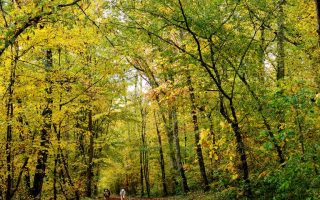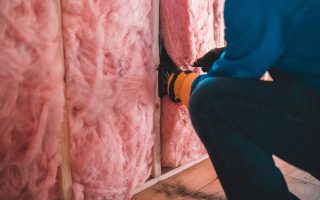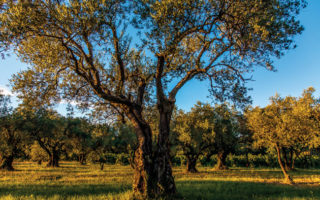‘We wanted to live a different kind of life’
Community


About five years ago Fiona and I decided that we both wanted to live a different kind of life – one that gave us freedom to live as we wanted. Neither of us wanted to work in an office; instead we wanted to live off the land as much as possible and have no debt. I had been a counsellor for some years and was disillusioned with the way people always wanted more than they had. Fiona’s earliest memories are of helping her Aunty Mary to collect the eggs and pluck chickens ready for Sunday lunch, and she wanted to return to this simpler way of life.
Back in Wales, where we both lived, we had a vegetable garden and reared our own animals – hens and a few weaners (young pigs) that were bought and raised for slaughter – so we felt comfortable taking the bigger step to being totally self-sufficient. We realised we would need an income, and before deciding to go self-sufficient gave a lot of thought to what we would do. The plan was for Fiona to give up her full-time job as a college lecturer in business studies and IT. I had already given up being a systems engineer and private counsellor some years earlier, and was turning wood. We decided that I would continue to do this while both of us bred and raised pigs, as well as providing all our own food from the rest of our land and animals.
Originally we planned to live in mid-Wales but we found it impossible to find something that was large enough for what we could afford. We also looked at the north of Scotland, including the Orkney Islands, and considered Romania. But in the end France offered us the chance to buy what we wanted, without a mortgage or in fact any credit at all, giving both of us the chance to leave full time employment and develop a business that revolved around our home and land.
We wanted an area with rolling hills, small fields and plenty of trees. Our main criteria for our home were a dwelling with a sound roof, five acres of land, running water on the property, extensive views and woodlands. Our first foray ended in frustration. From the UK we had arranged to see a number of properties with different estate agents that we thought fitted our brief, but all were totally unsuitable.
Then we travelled northeast arriving in the Indre where we felt at home amongst the hills, fields, plenty of woodland, picturesque villages and clear running rivers. When we explained what we wanted in a house to the French estate agent, he brought us straight to what is now our home.
I have to admit that at first I wasn’t at all keen because there wasn’t much to the house, but when the Dutch owner said it had five hectares, both Fiona and I realised that it might work for us. We walked the boundaries and imagined where the farm animals would be; where we could plant an orchard and where we could erect a polytunnel. Although the house needed a lot of work it had a sound roof and walls so we said ‘yes’.
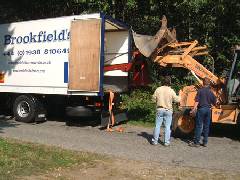
Moving in
The sale, however, did not proceed smoothly as our house sale fell through twice but eventually we sold our house in Wales, and in July 2004 set off for France in a van, along with three cats, our dog, Moss, a bathroom suite for the house and basic tools to get started. But when we arrived there were more problems – the vendor had delayed the sale as we had refused his demand for more money. We had nowhere to live, and ended up camping for 10 days until the owner capitulated. We finally moved in to Le Bois De Grammont on July 15.
We had two main tasks – to make the house habitable, and to start acquiring livestock. The house needed extensive renovation – two lights and one socket were the sum total of our electrical circuit, and a water tap in one corner of one of the two rooms was the plumbing. The wooden floors also needed replacing and we had a second floor to create from scratch.
On top of that, we had to wait until October before we could use some of our land – it had been used for five years by a local farmer to graze his Limousin cattle, and this was to continue until then. So we decided to start slowly – doing the most urgent jobs on the house and starting with just chickens and piglets. Everything else would come later.
Acquiring the chickens…
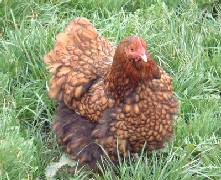
Golden orpingtons, our latest avian additions
Chickens were easy to find. From France Rural, a local agricultural supplier, we ordered 12 point of lay hybrid hens – those about to lay, not of a specific breed but known to lay abundantly, and likely never to go broody. As I speak no French at all, Fiona did all of the talking with her schoolgirl lingo. It seemed to work – one week later we collected the hens, transporting them in cardboard boxes. We housed them in the hen house that was here when we bought the smallholding – a lean-to made from concrete blocks. It has seen better days, but it was more than adequate. One drawback to ordering your stock like this is that you get what you are given; on the positive side though they came recommended by other smallholders.
Having had chickens before, we were more than confident about our French hens. Although we live close by the woods we have no problem with foxes but we have lost one hen to the buzzards which nest in our trees. But we think this is a small price to pay for the entertainment they offer us the whole year through.
Learning to castrate a piglet!
To get our pigs we started off at a Fête des Animaux in Bonnat, a nearby town. We were after three traditional breed coloured pigs instead of just pink ones, with loped ears similar to my favourite pig of all the ‘Gloucestershire old spots’. There were none there, but deciding we needed to get started quickly we compromised on multicoloured hybrids with pricked ears. We bought four piglets, each three months old, two females (sows) and two castrated males (boars). The two sows were the start of our breading nucleus and the two castrated boars for eating. The pigs cost us 76€ each which is very expensive in compassion to £15 in the UK. Fiona also managed to order and organise the collection of an un-castrated boar for two months later. She even managed to explain we would be keeping the pigs outside and would like a suitable breed for that purpose.
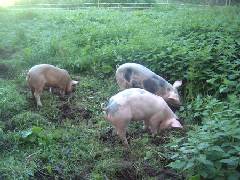
Pigs rooting around
Back at Le Bois De Grammont we deposited the pigs in a temporary enclosure of electric fencing with a house made of straw bales, hazel branches and recycled tin sheets, where they quickly settled in. Two months later we collected our boar ‘James Grieve’ from Monsieur Auroy, and at the same time bought a further breeding sow. These purchases have been the making of our success with pigs in more ways than one – Monsieur Auroy lives just a few kilometres away and over the past few years has helped us a huge amount.
Our first piglets were born in May 2005, and we asked Monsieur Auroy if he could help us castrate the male ones. We weren’t keen on the idea, but having been told that we wouldn’t be able to sell to the French market without castrating them, we felt we had no choice. M Auroy arrived one Saturday morning as arranged, and brought two men to help him. From our three litters, we had a total of 10 piglets to castrate. M Auroy set up a ‘workmate’ as an operating table, then asked me for the antiseptic spray, and indicated that he would like the first piglet.
Fiona passed the first animal to one of M Auroy’s helpers who carried him out of the sty to the operating table. He and the other helper held the piglet down on its side while M Auroy cut one side of the scrotum with a scalpel blade, squeezed out one of the testicles, pulled at it until he could feel some resistance, then cut the tubes connecting the testicle. Then he repeated the process on the other side. After that, the piglet got a quick spray of the antiseptic and the job was done.
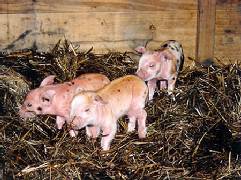
Some of our piglets
After M Auroy had castrated five piglets I indicated I would like to have a try. Under his close scrutiny I castrated the other five. I didn’t enjoy doing it at all – no anaesthetic is used and the piglets are obviously distressed throughout. It was an instructional experience and as a small holder I think it is my duty to take responsibility for our actions and conduct with our animals. So given the distress caused to the animal, and the fact that both Fiona and I have eaten un-castrated boar meat in the past, we decided castration was an unnecessarily cruel procedure so now we don’t castrate our piglets at all.
Instead we either kill them at an earlier age for customer consumption – before 23 weeks as this is when commercial producers consider boars start to taint their own meat due to the onset of puberty and the production of testosterone. Or we eat them ourselves. We have kept un-castrated boars for as much a nine months and still are unable to taste any difference that we consider to be negative. Extensive testing has proved that only 5% of boars taint their meat, yet 98% become fertile before they reach slaughter weight 100kg.
In November 2006 I received an email from someone who had seen our website. He had purchased two sows back in the spring for breeding purposes on his own holding, but his circumstances had changed and he was now looking for a home for his sows. Would I be interested in giving them a good home?
A couple of weeks later he delivered a Gloucestershire old spots and a Tamworth sow. We took them to an enclosure at the back of our property that had been planted with fodder beet back in March ready for winter-feed for the pigs. Since then we have fed them up ready for breeding. James Grieves our hybrid boar has covered the Tamworth successfully, and we have artificially inseminated the Gloucestershire old spots with Alsa Gerald 451 sperm from Deer Park in Northern Ireland.
Pigs are the mainstay of our financial income here in France; we sell pork as half-pigs, butchered ready for the freezer, as bacon or hand-made into sausages according to old English recipes. We do little marketing other than our own website and word of mouth. It seems to work though.
Rabbits: doe + buck = baby rabbits!
During September of 2004 an English neighbour gave us a couple of female rabbits in exchange for a pair of bunk beds that we no longer needed. Soon after we bought another two females and a male from the street market at Saint Aout.
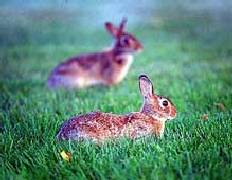
A couple of our rabbits
I set about building the three arks needed to house them using second-hand timber and chicken wire. By the time I had finished the days were getting short and winter was near.
Having never had rabbits before, I had been avidly reading books and websites. All suggested that rabbits would not breed unless they had 11 hours of daylight. By now we had a lot less than that, so thinking we were safe, we housed the buck with one of the doe’s for company. Ok, so you know what I’m going to say next… Yes, nine weeks later the doe gave birth to 11 bunnies.
Rabbits account for 100% of the white meat that we eat – they breed prolifically, taste better than chicken in our opinion, and convert grass to meat quickly. I can break their neck; skin and clean one in less than ten minutes, far quicker than similar can be done to a chicken.
Cows and crying calves
We had originally wanted to get just one Jersey, as a house cow to give us enough milk for ourselves. But at a village get together I was introduced to a local cattle farmer, Jean François, who had some cattle for sale – and things didn’t quite work out the way we planned!
Two days after we met, Jean François showed Fiona and me 14 or so different animals, some on his farm, others belonging to other farmers. Jean’s preference was for two sisters – both 3 years old – that were owned by his cousin. We said that we only wanted one cow, but Jean advised us that cows are much easier to keep if they have company.
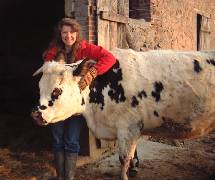
Fiona with Clover
We accepted his advice – since then Jean François and his family have become valued friends and a constant source of help and support. Also the agreed price was very good from our point of view – just 1200€ for the two. While one of the cows (Poppy) was in calf and due in four months, the following May, her sister (Clover) was not in calf so we asked if she could be put to the bull before delivery. This was agreed, as was the delivery date of the beginning of March.
While we had planned on a Jersey these were both Normande, a larger sized breed. I had never heard of them but I now know they are in fact a true dual-purpose cow unlike the Jersey. They will produce more milk of the same quality as a Jersey but good quality beef too, which cannot be said of the Jersey. They are docile in nature regardless of sex whereas the Jersey bull is said to be very aggressive.
Delivery of our cows was delayed until the end of March due to heavy snowfall in the previous weeks, and when they did finally arrive our ground was still waterlogged from the melting snow so the cows were put into the barn for a further week. When April arrived, though, so did the sunshine and the ground dried up very quickly. When the cows were let out they celebrated by running back and forth and kicking and jumping. We definitely had happy cows!
Only three weeks after their arrival, I did my daily early morning walk checking on all our stock before starting the feeding routine. I found Poppy laying down, looking somewhat distressed, with a pair of legs sticking out from under her tail. I had been reading up for weeks now on what to do if required to help deliver a calf – and now I had to put the theory into practice. I tried pulling the legs level as described in the book. But each time Poppy had a contraction the calf seemed to be pulled back in and out of line again.
Fiona called Jean François who arrived within minutes with his 14-year-old son, carrying what looked like an oversized car jack. Jean François examined the cow internally, and not finding the calf’s head as he would have expected – in line with the feet as if it was trying to dive out – he decided that it was time to call the vet. While waiting for him to arrive, Jean François did another internal inspection and this time found a tail. He then worked some magic – he and his son set up the jack, tied a rope around the calves feet and attached the rope to an arm on the jack. Then, during Poppy’s next contraction he simply jacked the calf out. Jasmine, as we called her, stood within an hour and fed from her mother – the sign that all was well. Jean François re-visited a couple of times during that day to make sure everything was ok and that no complications had arisen.
In May we found that Clover, our second Normandy cow, was not pregnant, despite being with a bull the previous month. We realised this when she came into heat and started patrolling the boundary of a neighbouring field in which there was a very handsome Limousin bull. We contacted Jean François who said that if we could wait until June, he would lend us a bull. We agreed to wait. June duly arrived and so did Teddy the Toro (our nickname for him), a Charolais. Both our girls enjoyed his company very much, encouraging him to return for repeated services during their heats. He was very able – in the spring of 2006 we had two very healthy calves, one heifer Camellia, and one bullock Paris.
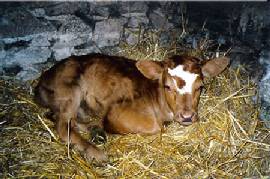
Jasmine as a calf
Then it was time for us to separate our first calf, Jasmine, from her mother so we could milk Poppy. We had never done this before and had, as usual, read up on the best way to do this. Although there are a few different options we decided that a straightforward and complete separation would be least painful all round. We were royally wrong.
All the books said both mother and calf would bellow for about three days, and then stop. For the first three days both Poppy and Jasmine bellowed as predicted. Thankfully, they did give us a rest for about six hours at night but woke us each morning at dawn.
True to the books, after three days Poppy stopped making a noise. Jasmine, however, did not stop bellowing, or crying. It was a pitiful task to feed her milk each day, watching tears streaming down her face. But when you’re a smallholder, there are many decisions like this that have to be made – it’s part of the life we have chosen.
We decided to get Jasmine a friend. Another calf was out of the question – 300€ was more than our guilt was worth, so we decided on a goat. We found Marigold, a pygmy goat, at Saint Aout market. Philippe explained that Marigold had also just been separated from her mother so might cry a little. And this she did.
The two newly bereaved babies cried and bellowed for a couple more days still, but eventually they became friends and it became quiet. Later Marigold was used as the companion for our new sheep, and then for the ram when he was separated from all the females. She was everyone’s friend including ours. I have to say she was a delight, even if a little naughty at times. Unfortunately, after some heavy snowfall, many of our neighbour’s trees bent over so they rested on the ground in her enclosure. Some were overgrown with ivy, and unfortunately Marigold ate some and died from poisoning. She is sadly missed.
Our initial thoughts on having a cow and using her milk for us have changed dramatically since we purchased our two Normande cows. The milk has become of pivotal importance in our whole farming philosophy. Milking is one of the first things we do each morning and evening and fresh whole milk is fantastic – we drink a very large coffee made with fresh milk every morning for breakfast following the morning feeding routine.
Every other day one of us separates the cream from the milk with a cream separator that was very kindly donated to us by Jean-François and his wife – during out first Christmas we gave them four boxes of butchered pork as a thank you for all they have done for us – and then we feed the skimmed milk to our piglets. The cream is of an exceptional quality and we are able to sell it at the farm gate, or of course consume it ourselves.
On the days we don’t separate the milk we make cheese, from English Cheddar & Stilton to French Saint Nectaire. This is only for our own use, though, and for some privileged friends. Whey, the by-product of cheese making, is also fed to the pigs.
Fiona has now started experimenting with ice-cream, making good quality vanilla or honey ice cream, and so now our plan is to make cheese for six months of the year and ice cream for the other six months. Both our cheese and ice cream will be sold in the future when we have perfected the quality and increased our herd to cope with demand.
Getting some geese
In June 2005 Fiona bought me a pair of 3-month-old Toulouse geese for my birthday. This was a no fuss purchase at Saint Aout market – until February the next year when a smallholder friend who lives in our village visited us and said that they both appeared to be behaving like males. Males of the geese species tend to be somewhat more vocal and considerably more aggressive, and these two had been both all winter long. We phoned the vendor Philippe (from whom we had bought the goat) who said to come by and he would re-sex them. We went along with our smallholder friend who wanted a pair of geese too.
Philippe sexed both geese and said yes they were both males. Apologising, he said he would gladly swap one for a female. We proposed an alternative plan – we would donate one of the males to our friend and we would both buy two females each; which as you might imagine pleased Philippe very much.
Pottering in the potager
We began our garden in February 2005. The weather in the first week was a glorious 18°c and not knowing any better – this is France, we thought! – we thought spring had arrived. So we erected our solar tunnel in anticipation of sowing some seed. The next week the overnight temperature dropped to below –15°c and the daytime temperature had trouble getting above 12°c. It also snowed and snowed, and then snowed some more. We enjoyed the wonderful clear view and the glorious snow covered scenes – but alas we did not get any seeds put in at all.
April arrived and so did the sun so we started again. By now the area for the vegetable garden – about 2400 square metres – was a mass of bare ground with not a speck of green to be seen, and nicely fertilised! We had allowed our pigs onto it and they had done a good job. We had purchased an old Harry Ferguson Tractor and now it was time for it to earn its keep. I ran over the area with just a spring tine cultivator to level it and break up the soil a little. Fiona took over from here.
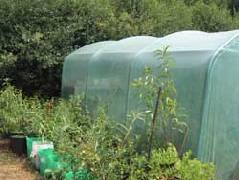
The polytunnel in the garden
Fiona showed me daily progress on all the seeds, both in the tunnel, which was now starting to pay back the investment, and in the garden. It was fantastic to see it all grow – and with temperatures of up to 42°c the plants just grew and grew. We have potatoes, swedes, sweet corn, pumpkins, onions, shallots, leaks, garlic, peppers hot and sweet, aubergines, Swiss chard, spinach, cabbage, carrots, fennel, cucumbers, courgettes, squashes of all shapes and sized, beans both tall and short, peas, melons, strawberries, red and black currants, goose berries, raspberries, and rhubarb.
Bleating on about Sheep
During 2006 we purchased six Dorset Downs sheep. We bought them directly from Pasqual Chenue, the breeder of the Paris Salon d’Agriculture 2006 champion. We got the first three in February, then in August we used the proceeds of selling the meat from our calves to purchase a further two ewes and a ram. We had to wait until November until our ram, Toby, was old enough to cover our ewes; in the meantime we used the overgrown garden of an English neighbour’s holiday home to house the ewes. Eventually the grass ran out and Toby eagerly waited the arrival of his flock of girls back at the ranch. Dorset Downs are an exceptionally good meat breed of sheep and as well as providing income from the sale to other discerning smallholders will provide us with some of our own meat, and of course rugs.
Goal achieved!
We had not planned on it but within one year of arriving, we were self-sufficient in food. We had vegetables and fruit from our garden, a selection of meat from our own livestock; eggs from our own chickens; milk, cream, and butter from our own cows, and by the autumn we were eating our own cheese. With the sheep, we had used up our financial reserves from the sale of our home in Wales – everything from that point had to be financed and provided by our smallholding, and this we have done.
The present: today all five ewes of our ewes are showing clear signs of pregnancy; Clover has been confirmed pregnant with a pure Normande calf, while we are still waiting to find out about Poppy. We have two pregnant sows, and Brambly has just had 11 piglets. Rabbits, well they breed like “rabbits” and we get plenty of eggs from a multitude of hens plus 30 goose eggs at last count. Now we want to extend our market and increase our stock.
It’s not always easy, some crops fail; cows don’t take the artificial insemination. The pigs sometimes lie on and crush their babies; its too hot to work sometimes and the grass goes dry in July.
But we have no regrets. The grass recovers by October, most of the piglets survive, the calves arrive eventually, we deserve to rest sometimes so why not when it’s hot? And most crops thrive, and I have the love of a very contented wife. The good life at Le Bois de Grammont goes on.
February 2008 – all change
One day whilst searching the internet Fiona and I fell over a video about ‘Peak Oil.’ It’s now over a year since we first discovered the issue and I now feel that I have a firm foundation of the issue and its implications for our future.
So if you know we are going to run short of the very thing that powers the present lifestyle of the developed world what do you do about it? In short you study and find out how best to weather the storm which many oil experts and pundits claim lie ahead of us.
Firstly for anyone who has not heard of or understood the concept of peak oil, I will explain it in layman’s terms. ‘Peak Oil’ is the point at which half of the world’s oil has been consumed. Some people say we are well away from this point and will not reach it until 2030, others provide evidence that we have already peaked back in May of 2005.
America peaked in oil production back in 1971 and as I write this oil reached a record high of US$102 per barrel and the BBC report that the oil producers’ cartel OPEC will cut supply even further when they meet next week.
Who is telling the truth? 2030 or 2005, I don’t know but the evidence suggests we have peaked, and we will start to see the effects of this now. Some even suggest that recent events in our economy are the direct result of ‘Peak Oil’ and I am inclined to agree.
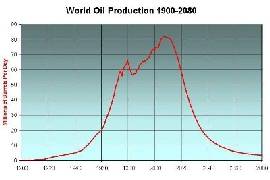 The experts say our economy has expanded in line with the oil production curve above.
The experts say our economy has expanded in line with the oil production curve above.
Why does this make any difference to the world economy? Our recent economic success is built on what is referred to as the oil economy (Oil Age.) Our economy since the war has been built on the availability of cheap energy from oil and natural gas. The oil production peak is arriving at a time when demand from developing countries like China an India is growing. This means that the price will go out of control, and the cheap energy our present economy is built on will collapse. Perhaps is even collapsing as I write this.
This does not mean the end of the world, but I believe it will have serious implications for our present life style.
So what do you study? Bush Survival, Combat skills, Shooting, Self Sufficiency, or Permaculture. Fiona and I have opted for Permaculture.
What is it? Two Australians (Bill Mollison and David Holmgren) coined the term back in the early 1970s. The term is derived from two other terms Permanent Agriculture and Permanent Culture. This basically means taking a long-term view of how to produce food and run society in a sustainably and which is not detrimental to the earth and its inhabitants, and running our economy for the benefit of all, and not just the few.
How does the above approach differ what we do now? Take for instance the ‘Peak Oil’ issue, if oil production has peaked, how will we farm in the future? For example, at this point in time all non-organic fertilisers are made from natural gas, all pesticides and herbicides are made from crude oil. Machines powered by oil-derived fuel produce most of our food; machines powered by electricity, generated using non-renewable resources process most of our food.
Much of our food is transported for hundred or even thousands of miles, by vehicles powered by oil-derived fuel. If the cost to each individual is prohibitive now, what will it be like in the future? This is to say nothing of oils detrimental affect on our atmosphere, soil, and subsequently our health.
Permaculture has nothing new to offer in terms of technology; Bill Mollison admits this in the opening chapter of his book ‘Permaculture A Designers Manual.’ What is does offer is an integrated design approach to long-term agricultural and cultural permanence.
One word of advice here if you decide to study Permaculture for yourselves ignore references to it being for vegetarians or vegans. Extremists, who espouse to vegetarian ideals, have to some extent hijacked permaculture, yet in no part of the texts or videos by its originators does it suggest we should all become vegans. Sadly it is difficult to source a course on Permaculture in the UK or France that caters for omnivores, which to my mind makes the courses somewhat exclusive. This attitude is evidently damaging to its popularity and acceptance to the mainstream audience, a shame given its plethora of possibilities for a more positive future for us all.
So how does Permaculture help us as smallholders cope with the rising price of oil? The list is vast so I will not be too exhaustive now. In our own case we have tried to be more rational about what we produce for the consumption of others.
Most of our income comes from raising pigs to sell as pork, bacon and sausage, but most of the food (barley) is purchased in from a neighbouring farmer. The barley is produced organically but still produced with modern conventional agricultural techniques which are vastly reliant on oil.
We believe this is totally unsustainable. If we are to continue to live off the land we need to move to a less fuel intensive way of raising stock. Traditionally pigs were raised outside in large pastures or in woodlands of oak and or chestnut and pigs can gain 100% of their nutritional requirements from this system. This system does not lend its-self to intensive high production methods and food was comparatively more expensive than we have come to expect. But this is where our future lies. We do not have enough woodland on our present property, so we have decided to move.
We also produce a full range of dairy produce, milk, butter, cream, ice cream, and cheese; we do this from hand-milked cows, on a supplemented diet. The only part of this that is not sustainable is the supplemented diet, so we will be going over to a grass-only system from this spring onward. As we will be producing less pork we will be expanding our dairy production; so extra grazing land will be needed for our growing herd.
We intend to vastly increase our poultry production both for meat and eggs, but we will be using a dramatically different system for feeding them. Presently we rely on them grazing and supplement this with grain, but as we expand our herd of dairy cows, we will rotate the chicken house behind the cows.
The cows will be rotated from one field to another to graze, as they do so they will deposit dung, this can lead to an irritating problem with flies that lay their eggs in the dung. But if we put the chickens in the field three days after the cows have left they will rifle through the dung to eat the fly larvae.
This does three things: it spreads the cow’s muck saving on labour, it decreases the fly population, and it feeds the chickens on a highly nutritious high protein diet for free.
These few measures will release us from our present dependence of oil intensive farming, and to some extent guard us against the inevitable inflation of future oil prices.
* Oil peak:
www.postcarbon.org
www.youtube.com/user/peakmoment
www.theoildrum.com
www.peakoil.net
www.lifeaftertheoilcrash.net
*Permaculture
www.permaculture.org.uk
www.permaculture.co.uk/main2.html
http://en.wikipedia.org/wiki/Permaculture
www.spiralseed.co.uk/permaculture
For more on Steve and Fiona take a look at their website: Le Bois de Grammont
Share to: Facebook Twitter LinkedIn Email
More in businesses, camping, courses, estate agents, garden, renovation, technology
By FrenchEntrée
Leave a reply
Your email address will not be published. Required fields are marked *

